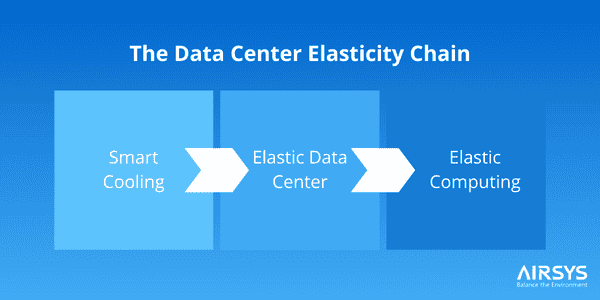
Current Cooling Limitations Slowing AI Data Center Growth
September 23, 2025
Managing AI Heat with AI Cooling in Data Centers
October 21, 2025Cloud elasticity has become a trending buzzword in the data center industry, particularly as hyperscalers, colocation, and AI-driven facilities expand. The ability to provision and de-provision computing resources dynamically based on demand is now seen as essential for performance, efficiency, cost control at scale, and smarter capacity planning.
But cloud elasticity doesn’t originate in software alone. It is rooted in the physical infrastructure that supports responsive and efficient computing, including the data center cooling system.
Why Elasticity Depends on Scalable Cooling?
Many data center operators and engineers view cooling through the lens of scalability: scaling capacity to meet rising heat loads, higher rack densities, and growing compute demands.
And while scalability and elasticity are not the same, they are closely connected, as elasticity is only achievable when the underlying infrastructure is scalable. In other words, you can only adjust resource levels if the system was designed to flex in the first place.
This means that modern cooling systems’ scalable capabilities enable the data center to adapt in real time to fluctuating IT demands, creating the conditions necessary for hardware to support the flexibility required by cloud computing.
How Does Cooling Enable Data Center Elasticity?
According to Synopsys, elasticity refers to the ability to increase or decrease the resources a cloud-based application uses. To enable this at the infrastructure level, the physical infrastructure that supports these applications (servers, GPUs, CPUs, and related hardware) depends on two critical resources: cooling and power.
Modern cooling is uniquely positioned to deliver both, making it a foundational enabler of data center elasticity. Here’s how:
1. Cooling Systems as a Cooling Resource
Advanced cooling systems, especially those designed for high-density, AI environments, are equipped with variable-speed components and AI-driven controls that monitor and automatically adjust airflow, coolant flow, and capacity in real-time.
This intelligent, dynamic allocation means cooling becomes a scalable resource, dispatched only when needed and with precisely matched output. As compute demand rises or falls, the cooling system flexes, maintaining thermal stability without wasting energy. This responsiveness is essential for supporting elastic IT environments, where compute loads may fluctuate due to changing user demands or AI model loads.
>Notably, this is one example of AI being used to cool AI, with machine learning algorithms dynamically optimizing thermal performance to match the needs of AI-driven workloads.
2. Cooling Systems as a Power Resource
Cooling systems are notoriously among the largest power consumers in data centers, often accounting for up to 40% of total energy usage. This creates direct competition for power with critical computing systems, limiting the ability to scale workloads or add high-density equipment.
To address this, energy-efficient cooling systems significantly reduce energy consumption, freeing up power that can be redirected to IT equipment. This enables data centers to scale their compute capacity not by expanding their power footprint, but by optimizing what they already have.
> This distinction reflects one of the core differences between scalability and elasticity. While scalability often requires adding physical resources, like servers or nodes, elasticity involves dynamically adjusting how existing resources are used. In this case, cooling enables that flexibility by ensuring that more of the available power can go toward computing, allowing faster, more agile workload adaptation within the same infrastructure.
Cooling as a Cloud Elasticity Enabler
As cooling systems become smarter and more energy efficient, their built-in flexibility sets the stage for infrastructure-level elasticity within the data center. But, as established earlier, an elastic data center can set the way for cloud-level elasticity.
When cloud-based workloads operate in optimal conditions (where cooling is dynamically managed and power is available on demand), the software layer can adjust resource consumption and performance in real time. These capabilities, which are made possible by advanced cooling infrastructure, allow cloud services to respond more fluidly to workload spikes, user demands, and application shifts.
In this way, cooling supports not just the data center’s smooth and uninterrupted operation, but also the flexibility and agility of cloud operations.

PowerOne™: Smart Cooling for Elastic Infrastructure
Smart, scalable cooling principles come to life in technologies like PowerOne — a high-efficiency, AI-optimized cooling solution designed for today’s most demanding data center environments.
PowerOne is built on a simple promise: Less power consumed on cooling, more power driving computing. Key capabilities that make PowerOne ideal for elastic infrastructure include:
- Intelligent, AI-based controls dynamically adjust cooling output in real time
- Air, liquid, and hybrid cooling configurations offer strategic flexibility in cooling delivery
- Modular design facilitates smooth and rapid expansion
- Compressor-free operations deliver up to 40% energy savings compared to traditional cooling methods
- 1.15 PUE
Altogether, PowerOne’s adaptive cooling capabilities, combined with the freed electrical capacity, enable IT infrastructure to support truly elastic computing.
Partner with AIRSYS for Smarter Cooling
The path to elastic computing starts with intelligent, scalable cooling. This makes modern cooling systems vital to reliable data center operations.
AIRSYS engineers advanced cooling systems, like the PowerOne product line, that give data centers the thermal intelligence and energy efficiency needed to support truly elastic infrastructure. Whether you’re operating a hyperscale facility, colocation environment, or AI-driven compute cluster, our solutions are built to grow with you. Contact us today to see how AIRSYS can support your next phase of growth.



